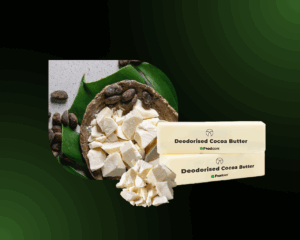- In 2024, cocoa butter prices reached historic highs, shaking up the global market.
- Droughts, rainstorms and plant diseases have significantly reduced the supply of cocoa, driving up prices.
- The food, cosmetics and pharmaceutical industries continue to increase demand for cocoa butter.
- Experts predict a moderate price drop in 2025, but climate and geopolitical uncertainty remain a threat.
The year 2024 proved to be a watershed year for the global cocoa butter market. Prices for the raw material reached historic highs and producers, processors and consumers faced a range of challenges – from natural disasters in West Africa to uncertainty in financial markets. Cocoa butter, which is a key ingredient in chocolate, cosmetics and pharmaceuticals, took centre stage for economists, investors and companies around the world.
Global cocoa butter market analysis 2024
In 2024, the prices of cocoa, and consequently cocoa butter, reached record levels. Their surge began at the end of 2023, but the first half of 2024 saw a real explosion. In April, a tonne of cocoa on the London Stock Exchange cost £10,173 – the highest level on record – and by June the average price was already US$8,271 per tonne, an increase of 160.7% year-on-year.
What was driving this steep rise?
One of the main factors was natural disasters in West Africa, a key cocoa-producing region. Droughts, heavy rains and plant diseases significantly reduced supply. Intense rainfall in October 2024 led to flooding of plantations, increased flower mortality and young cocoa fruit, reducing the projected crop in Côte d’Ivoire to 1.3-1.35 million tonnes, instead of the previously forecast 1.5 million tonnes.
A reduction in global supply also contributed to the price increase. Ghana and Côte d’Ivoire, the leaders in global cocoa production, have seen yield declines of more than 20%. In Ghana, illegal gold mining (galamsey), erratic weather conditions and crop disease have become additional problems, leading to the lowest level of cocoa exports in 14 years – less than US$2 billion.
Uncertainty in the market was also compounded by logistical and geopolitical factors. Transport blocs, rising energy prices and trade tensions have increased supply costs, while government interventions such as export limits have further undermined market stability.
Changing consumer preferences
Despite price increases, demand for cocoa butter has remained high. Why?
The boom in natural cosmetics has made cocoa butter products more popular than ever, as growing environmental awareness and the search for organic alternatives have driven consumers to choose natural ingredients.
Although some companies have tried experimenting with other vegetable fats, such as shea or coconut butter, none have offered the same velvety texture and stability in chocolate, proving that cocoa butter still has no full-fledged substitutes.
In addition, cocoa butter has started to be increasingly used in dietary supplements, especially in products that improve skin elasticity and support heart health, increasing its importance in the wellness and nutraceuticals industry.
Regional analysis of the cocoa butter market
The situation in the cocoa butter market varies from region to region – Africa is facing a crisis, Latin America is consolidating its position and Asia remains stable, although it is measuring itself against increasing demand.
West Africa
There is no getting around it – Côte d’Ivoire and Ghana have found themselves in a difficult situation. Droughts alternating with torrential rains have destroyed some crops, reducing the projected harvest to 650,000 tonnes – the lowest level in 13 years.
Farmers, faced with rising prices and low wages, have started to sell grains on the black market, further reducing supply and adding to the chaos in the market. The authorities are trying to counter these practices by tightening border controls and increasing financial support to farmers, but the effectiveness of these measures remains an open question.
An additional factor destabilising the market is government intervention. The governments of Ghana and Côte d’Ivoire have introduced export restrictions and price interventions to control prices in their home markets. However, the effect of these interventions has been the opposite of what was intended – they have introduced more uncertainty among producers, resulting in further price increases.
Latin America
Brazil and Ecuador, hitherto regarded as second-tier players, have gradually begun to increase their market share. Investment in new technologies has allowed yields to increase despite difficult climatic conditions. Modern irrigation and disease protection methods are making the region increasingly competitive.
The dynamic development of the organic cocoa segment is also attracting particular attention. Ecuador and Peru are betting on organic production of high-quality cocoa, which is in great demand in developed countries. Certified organic plantations allow for higher margins, making this sector attractive to investors.
Asia
Against the backdrop of the volatile situation in Africa and dynamic developments in Latin America, the Asian market stands out for its relative stability. As the region’s main cocoa producer, Indonesia has coped relatively well with the 2024 crisis, keeping exports stable. This has avoided sharp price spikes and the country remains one of the key suppliers of cocoa to global markets.
At the same time, demand for cocoa is growing on domestic markets, especially in China and India, where the chocolate industry is developing rapidly. Investment in local processing and the growing popularity of chocolate products in these countries could further strengthen Indonesia’s position as a significant player in the global cocoa market in the coming years.
2025 cocoa butter market trends and forecasts
Experts predict that cocoa butter prices may fall slightly in 2025, but there is no expectation of radical reductions.
- If weather conditions in West Africa improve, supply could increase, easing price pressure. However, climate forecasts do not provide clear answers – there is a risk of a return of weather anomalies.
- Producers are looking for alternatives – rising costs are forcing the food industry to test substitutes for cocoa butter, such as shea butter or vegetable fats. However, due to the unique properties of cocoa butter, there is no sign of a mass abandonment of its use.
- Demand continues to grow – the cosmetic, food and pharmaceutical industries have no intention of giving up cocoa butter. Premium and organic products are driving demand, especially in Europe and North America.
Will Latin America take over part of the market?
We are seeing a growing role for countries such as Ecuador and Brazil. Their political stability and investment in manufacturing could make them a serious alternative to West Africa, especially if local governments continue to struggle with regulatory uncertainty and infrastructure issues.
Sustainability and certification – a necessity, not an option
In response to market concerns, Fair Trade and Rainforest Alliance certifications will become even more important. Consumers are increasingly aware of the ethical aspects of cocoa production and are more willing to choose responsibly sourced products.
Summary
The year 2024 was one of the most volatile periods in the history of the cocoa butter market. Weather disasters, regulatory changes and investor exodus led to price spikes that shook the entire sector.

There is no clear answer as to whether 2025 will bring stability. If weather conditions improve and supply increases, we can expect a moderate price decline in the third quarter of this year. However, rising demand and continued geopolitical uncertainty could ensure that cocoa butter remains a strategic commodity whose cost will continue to challenge many industries.”
One thing is certain – cocoa butter processing and trading companies should prepare for further uncertainty and the need for a flexible approach to risk management. Investment in alternative cocoa sources, certification and new technologies may prove key to survival in a rapidly changing market.
Global Foodcom S.A. reports.
Curious about what’s next for cocoa butter? Discover the latest trends and insights that will shape the final months of 2025. Visit our blog as we regularly update our global reports. Stay up to date with Foodcom S.A.
![Cocoa butter market overview 2026 [Global Report] Cocoa butter market overview 2026 [Global Report]](https://foodcom.pl/wp-content/uploads/2025/02/przeglad-rynku-masla-kakaowego-w-2025-1520x760.png)


![Analiza rynku skrobi ziemniaczanej 2025 [Global Report] Analiza rynku skrobi ziemniaczanej 2025 [Global Report]](https://foodcom.pl/wp-content/uploads/2024/09/potato-starch-300x150.png)
![Analiza rynku białka grochu 2025 [Global Report] Analiza rynku białka grochu 2025 [Global Report]](https://foodcom.pl/wp-content/uploads/2024/10/pea-protein-blog-300x150.png)
![Przegląd rynku WPC 80 2025 [Raport globalny] Przegląd rynku WPC 80 2025 [Raport globalny]](https://foodcom.pl/wp-content/uploads/2024/11/global-report-wpc-300x150.png)


